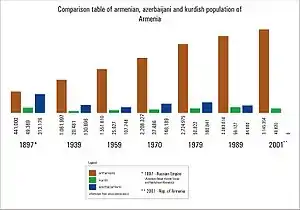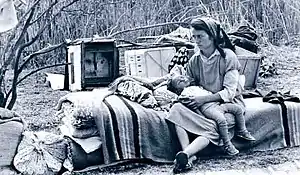Refugees in Azerbaijan
Azerbaijan has a large number of internally displaced people and refugees, mostly as a result of the Nagorno-Karabakh conflict. The First Nagorno-Karabakh war displaced 750,000 Azerbaijanis, with 600,000 of them being from Nagorno-Karabakh and the surrounding districts and the 150,000 of them being from Armenia.[1] Additional 40,000 people became displaced during the 2020 Nagorno-Karabakh war as a result of bombing and shelling of villages and cities by Armenian Armed Forces along the Nagorno-Karabakh Line of Contact.[1]
Refugees from Armenia

According to the 1979 census, Azeris numbered 160,841 and constituted 5.3% of Armenia's population.[2] Civil unrest in Nagorno-Karabakh in 1987 led to Azeris' being often harassed and forced to leave Armenia.[3] On 25 January 1988, the first wave of Azeri refugees from Armenia settled in the city of Sumgait.[3][4] Another major wave occurred in November 1988[4] as Azeris were either expelled by the nationalists and local or state authorities[5] or fled fearing for their lives.[6] Violence took place as a result of ethnic conflicts;[7] in November 1988, 25 Azeris were killed, according to Armenian sources (of those 20 in the town of Gugark during the Gugark pogrom);[8] and 217, according to Azerbaijani sources.[9]
Thus, in 1988–91 the remaining Azeris were forced to flee primarily to Azerbaijan.[5][10][11] It is impossible to determine the exact population numbers for Azeris in Armenia at the time of the conflict's escalation, since during the 1989 census forced Azeri migration from Armenia was already in progress. UNHCR's estimate is 200,000 persons.[6]
According to Azerbaijani government at the time of the ceasefire in 1994 there were about 250,000 Azeri refugees from Armenia.[12] According to the 1998 Citizenship Law they are all eligible for citizenship. By the end of 2001, UNHCR estimated that most of them were believed to have naturalized or be in the process of doing so.[13]
Internally displaced persons from Nagorno-Karabakh and the adjacent territories

During the First Nagorno-Karabakh War, territories constituting the former NKAO region of Azerbaijan and the seven adjacent rayons (some of them partly) were occupied by the Armenian forces. As a result, non-Armenians had to leave their homes. Azerbaijan now has one of the highest numbers of internally displaced persons (IDPs) per capita in the world.[14] The IDPs are presented in all of the 76 administrative districts in Azerbaijan. Initially, most of them lived in tent camps and public buildings such as schools, hostels, and dormitories. Since 2001, the Government increased its efforts to solve IDPs' problems. In 2002, the construction of new settlements started, and by the end of 2007, all tent camps were abolished.[12]
The Government of Azerbaijan with the help of the international community has started drafting a Framework Plan for the Return of IDPs to the occupied regions after the settlement of the Nagorno-Karabakh Conflict (The Great Return Programme).[12]
Meskhetian Turks
In 1944, Meskhetian Turks were deported en masse from Georgia to Central Asia by Joseph Stalin. One of the regions they resettled in was Fergana Valley, Uzbekistan. In 1989, interethnic violence occurred there triggering an evacuation of Meskhetian Turks from Uzbekistan. This group of refugees in Azerbaijan numbered about 50,000 people. According to the 1998 Citizenship Law, they are all eligible for citizenship. By the end of 2001, UNHCR estimated that most of them were believed to have naturalized.
Statistics
.jpg.webp)
According to State Committee of Republic of Azerbaijan for Refugees and Internally Displaced Persons, there were 603,251 IDPs in Azerbaijan in March 2009. The majority live in and around Baku, as well as in Sumgayit. Significant numbers of IDPs also live along the central-southern route of Füzuli–Aghdam–Agjabedi–Barda–Mingechevir–Ganja, the northern route of Shamakhi–Ismailli–Gabala–Sheki and the southern route of Sabirabad–Saatli–Imishli–Beylagan.[12]
Problems
Although relations between IDPs and the local population are generally amicable and there is a high level of tolerance among the local population, there are instances of conflicts arising due to the special status of IDPs (such as privileged access to employment, government financial assistance, free health services and property ownership privileges).[12]
Gallery
See also
References
- "HUMAN RIGHTS SITUATION OF INTERNALLY DISPLACED PERSONS IN AZERBAIJAN". humanrightsclub.net. 19 June 2019.
There are now about 600,000 registered Azerbaijani IDPs – roughly 40,000 from Nagorno-Karabakh and 560,000 from the surrounding seven occupied districts.
- (in Russian) All-Soviet Population Census of 1979 - Ethnic Composition in the Republics of the USSR: Armenian SSR. Demoscope.ru
- (in Russian) The Nagorno-Karabakh Conflict Archived 6 June 2011 at the Wayback Machine by Svante Cornell. Sakharov-Center.ru
- (in Russian) Karabakh: Timeline of the Conflict. BBC Russian
- After Independence by Lowell W. Barrington. University of Michigan Press, 2006; p. 231. ISBN 0-472-06898-9
- "International Protection Considerations Regarding Armenian Asylum-Seekers and Refugees. United Nations High Commissioner for Refugees. Geneva: September 2003" (PDF).
- The Unrecognized IV. The Bitter Fruit of the 'Black Garden' Archived 20 November 2008 at the Wayback Machine by Yazep Abzavaty. Nashe Mnenie. 15 January 2007. Retrieved 1 August 2008
- (in Russian) Pogroms in Armenia: Opinions, Conjecture and Facts. Interview with Head of the Armenian Committee for National Security Usik Harutyunyan. Ekspress-Khronika. #16. 16 April 1991. Retrieved 1 August 2008
- "Əsir və itkin düşmüş, girov götürülmüş vətəndaşlarla əlaqədar Dövlət Komissiyası". www.human.gov.az.
- "UNHCR U.S. Department of Homeland Security, Citizenship and Immigration Services Country Reports Azerbaijan. The Status of Armenians, Russians, Jews and Other Minorities".
- Country Reports on Human Rights Practices - 2004: Armenia. U.S. Department of State
- Refugees, United Nations High Commissioner for. "Azerbaijan: Analysis of Gaps in the Protection of Internally Displaced Persons (IDPs)". UNHCR.
- Refugees, United Nations High Commissioner for. "Refworld | International Protection Considerations Regarding Azerbaijani Asylum-Seekers and Refugees". Refworld.
- "Global Report on Internal Displacement". Internal Displacement Monitoring Centre. Archived from the original on 1 September 2018. Retrieved 5 September 2018.
External links
- The impact of the global food crisis on Azerbaijan - in pictures
- State Committee of the Republic of Azerbaijan on Deals of Refugees and Internally Displaced Persons
- The United Nations High Commissioner for Refugees
- The U.S. Committee for Refugees and Immigrants
- The Internal Displacement Monitoring Centre (IDMC)
- Danish Refugee Council

























